Railways

“Railways Redefined: Drone-Powered Insights for Optimal Asset Management, Progress Tracking, and Feasibility Surveys.”
The application of drones in the railway sector has significant implications for enhancing safety, efficiency, and overall operational effectiveness. Here are key aspects highlighting the significance of drone technology in the railway industry:
Infrastructure Inspection:
Drones can be used for inspecting railway tracks, bridges, tunnels, and other infrastructure. They provide high-resolution imagery and data, allowing for quick and thorough inspections without the need for manual intervention. This helps identify issues such as track defects, structural damage, or vegetation encroachment.
Track Maintenance and Monitoring:
Drones equipped with sensors and cameras can monitor the condition of tracks and detect abnormalities such as misalignments, wear and tear, or loose components. This proactive approach to maintenance helps prevent accidents and ensures the overall integrity of the railway network.
Safety and Emergency Response:
Drones can be deployed during emergency situations, such as derailments or accidents, to assess the extent of damage and guide emergency response teams. They provide real-time situational awareness, aiding in quick decision-making and response efforts.
Surveying and Mapping:
Drones can conduct aerial surveys to create detailed maps of railway corridors. This information is valuable for planning new rail routes, optimizing existing infrastructure, and assessing the impact of environmental factors on the railway network.
Security and Surveillance:
Drones enhance security by providing surveillance over railway yards, stations, and critical infrastructure. They can monitor for unauthorized access, identify potential security threats, and contribute to overall safety and security measures.
Vegetation Management:
Drones can be used to monitor and manage vegetation along railway tracks. They identify areas where vegetation poses a risk to safety by encroaching on tracks or obstructing signals. This helps in planning and executing targeted vegetation control measures.
Asset Management:
Drones assist in the inventory and management of railway assets. They can capture data on the condition of rolling stock, signaling equipment, and other assets, supporting maintenance planning and lifecycle management.
Remote Inspection in Challenging Environments:
Drones can access difficult-to-reach or hazardous locations, such as elevated structures or steep embankments, for inspections. This improves the efficiency of inspections and reduces risks associated with manual inspections in challenging environments.
Data Analytics and Predictive Maintenance:
Drone-collected data, when integrated with analytics, supports predictive maintenance models. This enables railway operators to anticipate potential issues, schedule maintenance proactively, and minimize downtime.
Cost Efficiency:
Drones contribute to cost efficiency by reducing the need for manual inspections, minimizing operational disruptions, and optimizing maintenance efforts. This results in overall cost savings for railway operators.
In summary, the significance of drone applications in the railway sector lies in their ability to enhance safety, efficiency, and data-driven decision-making. Drones contribute to proactive maintenance, emergency response, and overall improvements in the management and security of railway infrastructure.
